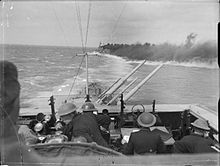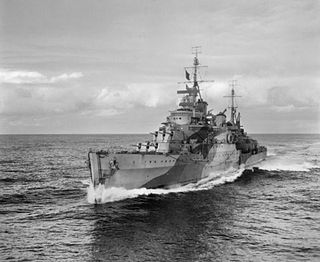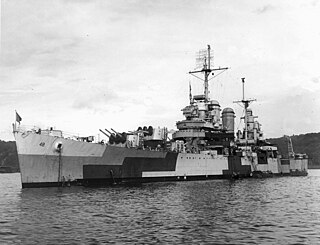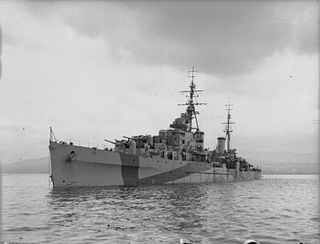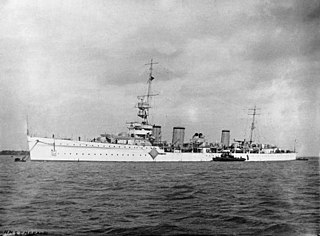 Argonaut in wartime camouflage, November 1943 just after repairs at the Philadelphia Navy Yard | |
| Class overview | |
|---|---|
| Name | Dido class |
| Operators | |
| Preceded by | Arethusa class |
| Succeeded by | Fiji class |
| Subclasses |
|
| Built | 1937–1943 |
| In commission | 1940–1980s |
| Completed | 16 |
| Lost | 5 |
| Scrapped | 11 |
| General characteristics (as built) | |
| Type | Light cruiser |
| Displacement | |
| Length | 512 ft (156.1 m) (o/a) |
| Beam | 50 ft 6 in (15.4 m) |
| Draught |
|
| Installed power |
|
| Propulsion | 4 shafts; 4 steam turbines |
| Speed | 32.25 knots (59.73 km/h; 37.11 mph) |
| Range | 4,850 nmi (8,980 km; 5,580 mi) at 11 knots (20 km/h; 13 mph) |
| Complement |
|
| Sensors and processing systems |
|
| Armament |
|
The Dido class consisted of sixteen light cruisers built for the Royal Navy during World War II. The first group of three ships were commissioned in 1940; the second group of six ships and third group of two were commissioned between 1941 and 1942. A fourth group, also described as the Improved Dido or Bellona class (five ships) were commissioned between 1943 and 1944. Most members of the class were given names drawn from classical history and legend. The groups differed in armament, and for the Bellonas, in function. The Dido class were designed to replace the C-class and D-class cruisers as small fleet cruisers and flotilla leaders for the destroyer screen. [1] [2] As designed, they mounted five twin 5.25-inch high-angle gun turrets on the centreline providing dual-purpose anti-air and anti-surface capacity; the complex new turrets were unreliable when introduced, and somewhat unsatisfactory at a time when the UK faced a fight for survival. During the war, the original 1939-42 ships required extensive refit work to increase electrical generating capacity for additional wartime systems (notably radar and gun direction equipment) and in the final Bellona, HMS Diadem, fully-electric turrets. While some damage was experienced initially in extreme North Atlantic weather, changes to gun handling and drill partially mitigated the problems. The fitting of the three forward turrets in the double-superfiring A-B-C arrangement (although in Royal Navy classification, fifth turrets were called "Q", not "C") relied upon the heavy use of aluminium in the ships' superstructure, and the lack of aluminium after the evacuation of the British Army from France was one of the primary reasons for the first group only receiving four turrets, while the third group received four twin 4.5-inch mounts and no 5.25-inch guns at all. [3] The Bellonas were designed from the start with four radar-directed 5.25-inch gun turrets with full Remote Power Control and an expanded light anti-aircraft battery, substantially increasing their efficiency as AA platforms.
Contents
- Armament
- Service
- Ship modifications
- Didos
- Bellonas
- Post-war development
- Ships in class
- See also
- Notes
- Citations
- References
- External links
From the initial trials of the lead ship Bonaventure, the new light cruisers were considered a significant advancement and were surprisingly effective in later actions in the Mediterranean Sea, such as protecting convoys to Malta, seeing off far larger ships of the Italian Royal Navy. [3] The 5.25-inch (133 mm) gun was primarily an anti-surface weapon but designed to fire the heaviest shell suitable for manual loading for use in anti-aircraft defence, and accounted for around 23 aircraft and deterred far more[ citation needed ]. Both the Didos and Bellonas were dogged by roller path jams in the rail track upon which the turret gunhouses rotated. These issues regularly put turrets out of action from their initial sea trials until the last operational service of Euryalus and Cleopatra with the RN in 1953–54 [4] [ full citation needed ], and were the bane of the three Bellonas operated postwar by the RNZN. [5] [ full citation needed ]. The original Dido-class ships HMS Bonaventure, HMS Charybdis, HMS Hermione and HMS Naiad were lost in the war. The sole survivor, name ship HMS Dido, was put into reserve in 1947 and decommissioned ten years later. HMS Euryalus was the last of the original class to see service, being decommissioned in 1954 and scrapped in 1959.
The Bellona class (as well as four rebuilt Didos) were mainly intended as picket ships for amphibious warfare operations in support of aircraft carriers of the Royal Navy and United States Navy in the Pacific. HMS Spartan was the only ship of the sub-class to be sunk, struck by a German Fritz X glide bomb while supporting the landings at Anzio. Two ships were to be modified to be command ships of aircraft carrier and cruiser groups, intended for action against planned German battlecruisers. Originally these were to be Scylla and Charybdis of the third group, but the 1943 loss of Charybdis saw Royalist of the fourth (Bellona) group selected instead; these were also known as the Modified Dido.
Postwar modernisation proposals were limited by the tight war emergency design. There was insufficient space and weight for the fire control and magazines of four or five modern twin 3-inch turrets, combined with the fact that the 5.25" shells had a much larger bursting charge than the smaller 4.5 inch guns in service postwar, making them more effective high-altitude AA weapons. [6] HMS Royalist was rebuilt for potential action alongside the battleship HMS Vanguard against the post-war Soviet Sverdlov-class cruisers and Stalingrad-class battlecruisers, and was loaned to the Royal New Zealand Navy (RNZN) from 1956 to 1966.
